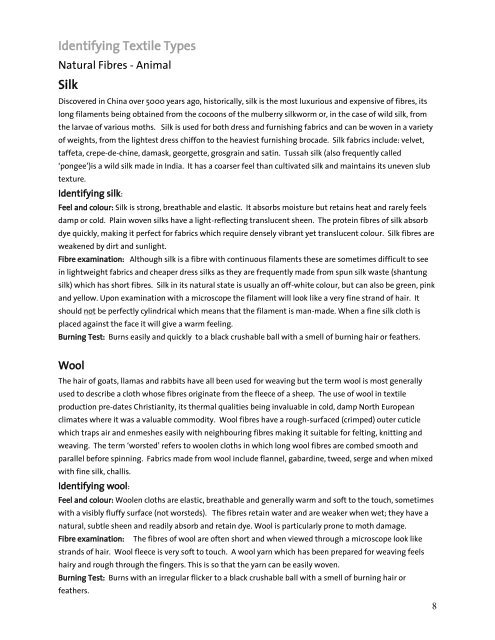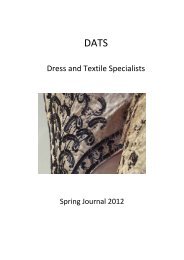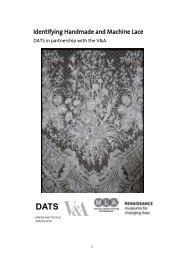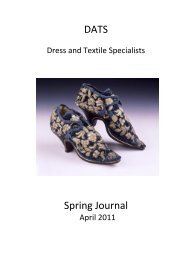Identifying Textile Types and Weaves 1750-1950 - Dress and Textile ...
Identifying Textile Types and Weaves 1750-1950 - Dress and Textile ...
Identifying Textile Types and Weaves 1750-1950 - Dress and Textile ...
You also want an ePaper? Increase the reach of your titles
YUMPU automatically turns print PDFs into web optimized ePapers that Google loves.
<strong>Identifying</strong> <strong>Textile</strong> <strong>Types</strong><br />
Natural Fibres - Animal<br />
Silk<br />
Discovered in China over 5000 years ago, historically, silk is the most luxurious <strong>and</strong> expensive of fibres, its<br />
long filaments being obtained from the cocoons of the mulberry silkworm or, in the case of wild silk, from<br />
the larvae of various moths. Silk is used for both dress <strong>and</strong> furnishing fabrics <strong>and</strong> can be woven in a variety<br />
of weights, from the lightest dress chiffon to the heaviest furnishing brocade. Silk fabrics include: velvet,<br />
taffeta, crepe-de-chine, damask, georgette, grosgrain <strong>and</strong> satin. Tussah silk (also frequently called<br />
„pongee‟)is a wild silk made in India. It has a coarser feel than cultivated silk <strong>and</strong> maintains its uneven slub<br />
texture.<br />
<strong>Identifying</strong> silk:<br />
Feel <strong>and</strong> colour: Silk is strong, breathable <strong>and</strong> elastic. It absorbs moisture but retains heat <strong>and</strong> rarely feels<br />
damp or cold. Plain woven silks have a light-reflecting translucent sheen. The protein fibres of silk absorb<br />
dye quickly, making it perfect for fabrics which require densely vibrant yet translucent colour. Silk fibres are<br />
weakened by dirt <strong>and</strong> sunlight.<br />
Fibre examination: Although silk is a fibre with continuous filaments these are sometimes difficult to see<br />
in lightweight fabrics <strong>and</strong> cheaper dress silks as they are frequently made from spun silk waste (shantung<br />
silk) which has short fibres. Silk in its natural state is usually an off-white colour, but can also be green, pink<br />
<strong>and</strong> yellow. Upon examination with a microscope the filament will look like a very fine str<strong>and</strong> of hair. It<br />
should not be perfectly cylindrical which means that the filament is man-made. When a fine silk cloth is<br />
placed against the face it will give a warm feeling.<br />
Burning Test: Burns easily <strong>and</strong> quickly to a black crushable ball with a smell of burning hair or feathers.<br />
Wool<br />
The hair of goats, llamas <strong>and</strong> rabbits have all been used for weaving but the term wool is most generally<br />
used to describe a cloth whose fibres originate from the fleece of a sheep. The use of wool in textile<br />
production pre-dates Christianity, its thermal qualities being invaluable in cold, damp North European<br />
climates where it was a valuable commodity. Wool fibres have a rough-surfaced (crimped) outer cuticle<br />
which traps air <strong>and</strong> enmeshes easily with neighbouring fibres making it suitable for felting, knitting <strong>and</strong><br />
weaving. The term „worsted‟ refers to woolen cloths in which long wool fibres are combed smooth <strong>and</strong><br />
parallel before spinning. Fabrics made from wool include flannel, gabardine, tweed, serge <strong>and</strong> when mixed<br />
with fine silk, challis.<br />
<strong>Identifying</strong> wool:<br />
Feel <strong>and</strong> colour: Woolen cloths are elastic, breathable <strong>and</strong> generally warm <strong>and</strong> soft to the touch, sometimes<br />
with a visibly fluffy surface (not worsteds). The fibres retain water <strong>and</strong> are weaker when wet; they have a<br />
natural, subtle sheen <strong>and</strong> readily absorb <strong>and</strong> retain dye. Wool is particularly prone to moth damage.<br />
Fibre examination: The fibres of wool are often short <strong>and</strong> when viewed through a microscope look like<br />
str<strong>and</strong>s of hair. Wool fleece is very soft to touch. A wool yarn which has been prepared for weaving feels<br />
hairy <strong>and</strong> rough through the fingers. This is so that the yarn can be easily woven.<br />
Burning Test: Burns with an irregular flicker to a black crushable ball with a smell of burning hair or<br />
feathers.<br />
8





